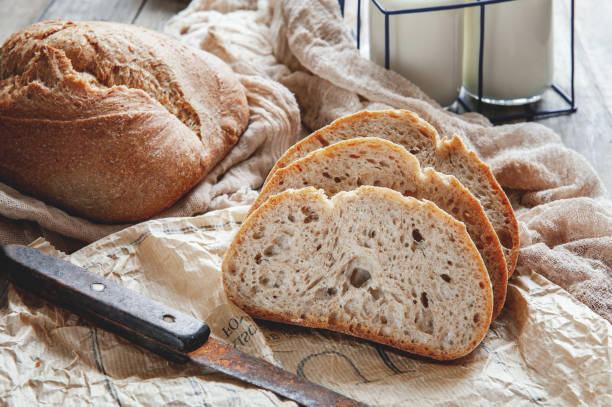Sourdough bread is a type of bread that is made by fermenting dough using naturally-occurring wild yeast and bacteria, rather than commercially-produced yeast. Sourdough bread has been made for thousands of years, and was a staple food in many ancient civilizations. Today, it is enjoyed by people all over the world for its unique flavor and texture.
One of the main concerns people have when it comes to bread, and sourdough bread in particular, is its calorie content. Many people are trying to watch their calorie intake to maintain a healthy weight or to lose weight, and they want to know how many calories are in their food. So, how many calories are in sourdough bread?
The answer to this question depends on several factors, such as the size of the slice, the ingredients used to make the bread, and the method of preparation. However, a typical 2-ounce slice of sourdough bread contains about 150-200 calories.
It’s important to note that this calorie content will vary depending on the type of flour used, for example white flour, whole wheat or even mixes. If other ingredients are added, such as seeds, nuts, or dried fruits, the calorie content will also increase. Additionally, the way the bread is prepared, such as using butter or oil, will affect the calorie content as well.
When it comes to weight loss, calories are not the only consideration. In fact, sourdough bread is considered a more nutritious option than many other types of bread. Because sourdough bread is made through natural fermentation, the wild yeast and bacteria break down the carbohydrates and gluten in the dough. This fermentation process makes the bread easier to digest and increases the bioavailability of nutrients such as vitamins and minerals.
Sourdough bread is also considered to have a lower glycemic index than other breads. The glycemic index (GI) is a measure of how quickly a food raises blood sugar levels. Foods with a high GI are rapidly absorbed and cause a rapid and large increase in blood sugar levels, while foods with a low GI are absorbed more slowly and cause a slower, smaller increase. Sourdough bread has a lower GI than other breads because the fermentation process breaks down some of the carbohydrates, making them more slowly absorbed by the body.
Another benefits is, the sourdough bread has a special microflora that can improve gut health and help balance the gut microbiome. Which can lead to better digestion and overall health.
Sourdough bread is also a good source of fiber, which is important for maintaining a healthy digestive system and may aid in weight management. It also provides important minerals such as iron and zinc, as well as B-vitamins such as niacin and thiamine.
It’s important to note that, while sourdough bread is a more nutritious option than many other types of bread, it should still be consumed in moderation as part of a balanced diet. Portion control is key to keep the calorie intake in check.
Another concern with sourdough bread is that, because it’s made with wild yeast, it may contain traces of mold. While many people find this to be a desirable aspect of the bread’s flavor, others may find it less appealing. Some bakers also include vinegar, baking soda or other ingredients that can neutralize the acidity of the dough and that can affect the final calorie count.
In conclusion, sourdough bread is a delicious and nutritious option for those who enjoy bread, and it’s not as high in calories as many people believe. A typical 2-ounce slice of sourdough bread contains about 150-200 calories, but this can vary depending on the ingredients and preparation method. Sourdough bread is also considered to be a more nutritious option than other types of bread, and it’s an excellent source of fiber, vitamins and minerals. Enjoyed in moderation and controlled portion, sourdough bread can be a healthy and delicious part of any diet.

 Home
Home Health
Health Diet & Nutrition
Diet & Nutrition Living Well
Living Well More
More













